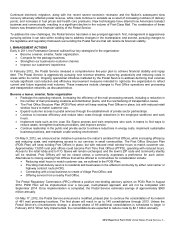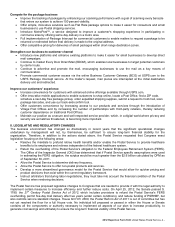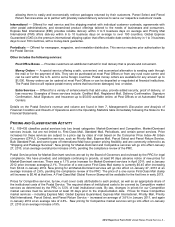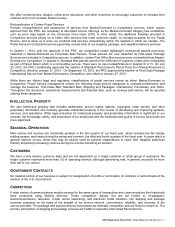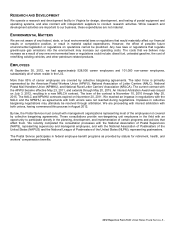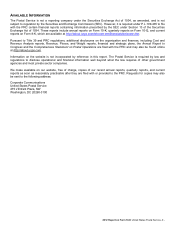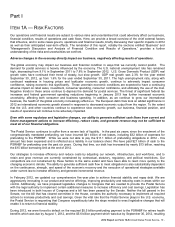US Postal Service 2012 Annual Report Download - page 13
Download and view the complete annual report
Please find page 13 of the 2012 US Postal Service annual report below. You can navigate through the pages in the report by either clicking on the pages listed below, or by using the keyword search tool below to find specific information within the annual report.2012 Report on Form 10-K United States Postal Service- 12 -
Our need to restructure our operations in response to declining mail volumes may result in significant costs. It is
possible that the measures being considered may be insufficient to reduce our workforce and physical
infrastructure to a level commensurate with lower and declining mail volumes.
Our current network optimization plans include the consolidation of certain mail processing operations, and reductions in
lobby hours of many retail units, Post Offices, and other facilities. At the current time, our regular review of the carrying
value of our assets has not resulted in significant impairments of our physical assets. However, future changes in
business strategy, legislation, government regulations, or economic or market conditions may result in material
impairment write-downs of our assets. We may, in the future, consider offering financial incentives to encourage
employees to voluntarily leave the Postal Service, as has been done in the past. Such impairments, incentives, or other
related costs would adversely impact our financial results in the short-term, although they would result in long-term
savings. In addition, there is no assurance that the mechanisms available under existing law and contractual
arrangements will be sufficient to reduce the workforce or facilities to a level that would allow a return to financial stability.
Our business and results of operations are adversely affected by electronic diversion. If we do not compete
effectively with electronic communications services, or alternatively grow marketing mail and package services,
or increase revenue and profit margins from other sources, this adverse impact will become more substantial
over time.
Customer usage of postal services continues to shift away from transactions, correspondence, and Periodicals Mail
toward advertising and Shipping Services. Advertising and Shipping Services are highly correlated with economic activity.
Over the past five years, transactional mail, such as the presentment and payment of bills, has been sharply eroded by
competition from electronic media, driven by some of our major mailers who actively promote the use of online services.
Factors underlying this trend include growing internet access in homes, increased availability of broadband service,
expansion of mobile internet access, increasing familiarity and comfort with the internet, and the growing trend by
businesses to incent or require their customers to use alternatives to mail for payments and statement presentment.
Correspondence mail has long been a declining part of mail volume. With the availability of e-mail and other internet-
based forms of communication such as e-cards and social networking, and inexpensive telephone service, there is little
chance that the decline in correspondence mail will be reversed.
The volume of Periodicals Mail continues to decline as people increasingly use electronic media for news and information.
The impact of the recession and electronic competition has amplified the steep decline in periodicals advertising.
Existing laws and regulations, including the Postal Accountability and Enhancement Act (P.L. 109-435) which
became law in 2006, limit our ability to introduce new services or products, enter new markets, generate new
revenue streams, or manage our cost structure, and thus grow and evolve as an important American institution.
In order to offset declining volumes and revenues caused by electronic diversion, our ability to sell new products and
services in new or existing markets will be a key factor to our return to profitability. However, various laws and regulations
seriously limit our ability to enter new markets and/or to provide new services and products as defined by traditional
industry definitions. Without legal or regulatory changes that allow us to introduce new products or services to take
advantage of our assets, including our strong network and last-mile capabilities, we may be unable to respond to
consumers’ changing needs and expectations. These limitations have the potential to adversely impact our results of
operations and long-term financial viability.
While the Postal Accountability and Enhancement Act (P.L. 109-435) limited price increases on our Market-
Dominant services to the rate of inflation, our costs are not similarly limited. Accordingly, we may not be able to
increase prices sufficiently, or generate sufficient efficiency improvements, to offset increased costs. This would
adversely affect our results of operations.
P.L. 109-435 limits price increases on our Market-Dominant services to the rate of inflation as measured by the CPI-U.
However, our costs are not similarly limited. A large portion of our cost structure is fixed and cannot be altered
expeditiously in the short run. Accordingly, we may not be able to increase prices sufficiently to offset increased costs.
Because our services are provided primarily through people, postal costs are heavily concentrated in wages, and
employee and retiree benefits. These costs are significantly impacted by wage inflation, health benefit premium increases,
retirement and workers’ compensation programs, cost-of-living allowances, and the continuous expansion of our delivery
network. Some of these costs have historically tended to increase at a higher rate than inflation as measured by the CPI-
U. We believe that continuing productivity improvements, by themselves, will not be sufficient to address the challenge
presented by declining volumes and revenues and the regulatory price cap; nor will revenue enhancements keep pace
with increased cost structures.



